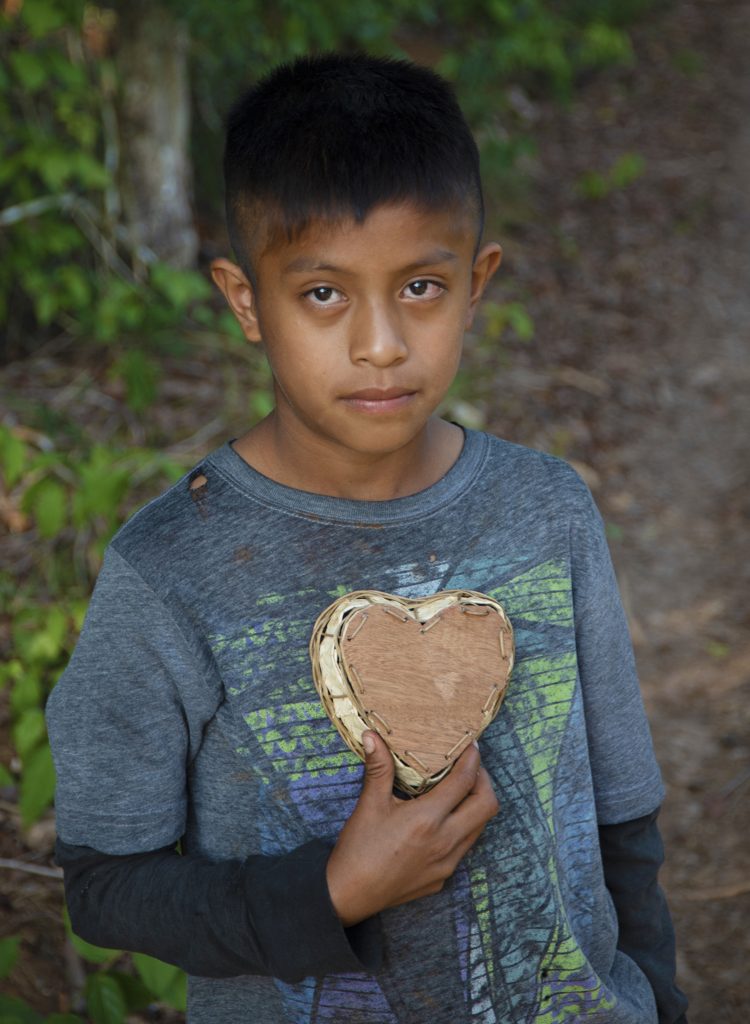Matters of the Heart
Guatemalans express gratitude for Project Indiana with universal symbol of love

Not one of the 18 Indiana electric cooperative lineworkers or support crew who traveled to Guatemala in spring 2019 as part of the continuing “Project Indiana” initiative spoke Q’eqchí, the indigenous Mayan language where they traveled. But they understood the gratefulness of the villagers of San Jacinto who spoke with their hearts.
The universal symbol for love and affection was displayed to them time and again by villagers — just as it had been on the three previous trips Project Indiana has made to Guatemala since 2012. Through both the symbol and words translated from Q’eqchí and Spanish, the heartfelt thanks warmed the hearts of the Hoosiers who came to extend power lines into their eastern Guatemala village.
The fourth Project Indiana trip was March 24 – April 9, 2019. On this trip, the crew worked in the Alta Verapaz Department near its border with the department of Petén. The 2015 trip also worked in Alta Verapaz but farther to the south and west. Trips in 2012 and 2017 were in the northwestern mountainous regions of Guatemala near the southern Mexican border.
As crews wired the 90-some homes for the electricity that was to soon be flowing, one came upon a sign 3-year-old Marco Bicbai Cancucul had left along the dirt path up that led to his front porch. He may not have meant it specifically for the lineworkers, but there lay a heart sculpted from a foot-long piece of wire. Other strands the short scrap were poked into the ground.
Marco’s home was through some dense foliage in the center of the village just behind the warehouse the crew used during their three-week project. Marco probably pulled the strand of wire from a scrap pile the linecrew started when cleaning out trucks at the end of each day.
His mother said Marco liked pulling apart the twisted strands and then creating shapes with the individual strands. Shy at first, Marco then seemed to take pride in showing off his heart and posing for photos with it across his chest.

Marco is the youngest of six siblings. The rest were at school that day. Their parents said they hope having lights at night will help their children study better to prepare for school. And they hope adding new electric appliances will make their hardscrabble lives a little easier.
Atop one of the steep hills at the far end of San Jacinto, a boy, probably in his early teens, stood in the shadows of trees on a late afternoon tapping his machete on wood. When he’d finally caught the attention of the Hoosiers working nearby, he held up a little basket to his chest. Its wooden bottom was fashioned from the machete also in the shape of a heart; its sides were woven from long blades of butter-colored grass held in place by small sticks glued together. The boy later gave the basket as a gift to Travis Goffinet when the lineworker from Southern Indiana Power came to make sure the lights were on when the electricity started flowing throughout the village.
In 2015, when Indiana also worked within the region, young girls showed their appreciation by forming hearts with their fingers and hands.
For Enrique Rax Yat, home is where the heart is. The 45-year-old San Jacinto community leader, like so many of the community leaders who serve on electric co-op boards in Indiana, is also a parent. Like them, he wants to see his four young adult children find opportunities nearby and be successful and raise their families there. He doesn’t want to see them go off to larger distant cities in Guatemala or even the United States to find their futures.
Enrique was among those who first began asking that the area’s utility, Farmers’ Development Association Las Conchas, extend its power lines to San Jacinto six years ago. He now represents San Jacinto at the association. “Electricity will give them opportunities to compete to achieve something more,” he said of his children and the children of the village.
Enrique and his wife were home when the electricity was turned on April 2. “It was beautiful,” he said. “I prayed, ‘Thank you, God, for this achievement.’” And he thanks Indiana.
“I can’t describe it. Words and pictures don’t do it justice,” said Jamie Bell, a coordinator of the San Jacinto project from NineStar Connect. Bell has left a little bit of his own heart in Guatemala. And, since coming home from what was his second project there, he has joined the non-profit Project Indiana board.
“You see how hard they work for the little they have,” Bell said. “Electricity gives them a powerful tool to better themselves — to make them want to stay there. With it, they’ll have better health, better schools, just an all-around better way of life. I just feel as if there’d be something wrong with any of us if we didn’t want the best for people like that.”
In other words, helping good and grateful people — whose lives are so hard and have so little — through Project Indiana is yet another way Hoosiers continue to show they, too, have a heart.
